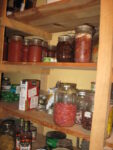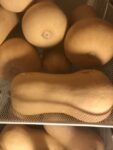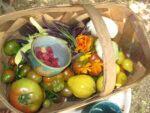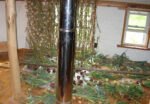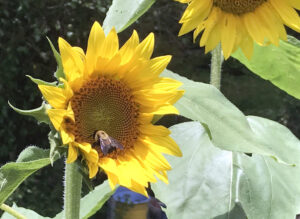A version of this column first ran in the Roane County (WV) Reporter and Times Record as part of a gardening series. Support local journalism! Subscribe to your local newspaper. This is one of a series of blogs for new gardeners. Start reading the whole series here: Part 1.
The number one reason I’m a serious gardener is that I want to produce food for my own household; that way I know it’s clean and wholesome, I save money, I get good healthy exercise and I enhance my household’s security in uncertain times.
If filling your larder is also important to you, you probably started out by growing vegetables. These are the most obvious, fastest and probably easiest to grow. It isn’t all that difficult to grow most of the vegetables a household uses—and mistakes are easily corrected since these are annual plants. If you decide you picked the wrong variety or method, you can just try something different next year.
Fruits might be your next food-growing venture. These are perennials, from the one low garden crop—strawberries, through bush berries—blueberries, blackberries, raspberries, goumi berries; and vines, grapes and kiwis—to the trees that provide apples, pears, peaches, cherries, and other fruit. So there is more of an investment and it isn’t as easy to correct an error. But strawberries will be providing food in one year, and most of the other berries within two or at most three.
If you’re more adventurous, next you might set yourself up with some kind of livestock—probably starting with chickens, the easiest and cheapest option, delivering lovely eggs packed with protein and other nutrients. Ducks are another good source of eggs. People usually raise turkeys for meat but they also lay a surprising number of very large eggs. Or you might have goats or a cow, for milk and cheese. Any of these can also provide meat, along with sheep and pigs. And rabbits.
Perhaps the last thing you’ll try to provide for yourself is the “staff of life”—grain for bread and cereal, and perhaps also to feed livestock. People think it isn’t feasible to grow grain on a backyard scale but it can be done. The book on the subject is Gene Logsdon’s Small Scale Grain Raising. I have a copy, which I have consulted often. But I’m sorry to say it ain’t that easy; Lodgsdon’s operation was a few acres (he’s dead now, unfortunately as he was an amusing and informative writer) in flat Ohio and he had some heavier equipment, well, heavier than anything I’ve got.
Logsdon and every other source I’ve seen agree that the easiest grain is corn. It likes a rich soil and adequate moisture and full sun, but given those basic conditions it will generally provide a heavy crop of highly palatable food that all livestock like; you can grow popcorn and sweet corn as well as the field corn used for cornmeal and animal feed. The newer, super sweet corn varieties must be isolated from others, however.
If growing corn as a grain, you let it dry in the field, usually harvesting it in October here—maybe September depending on the variety, when you planted it, and the weather. If it’s wet in the fall you may have mold problems, and corn molds can be toxic and even carcinogenic. In a pinch you can finish the drying under cover. I’ve sometimes strung ears to ropes in my kitchen, tying them onto the rope by their husks.
Shelling the corn can be done by twisting or rubbing two ears against each other (with gloves on, maybe); you can buy a simple metal ring with nubbins on the inside that makes this easy. It shouldn’t be done until the ears are totally dry and hard. For corn, that’s it—put the fully hard, dry seed in jars or bins (mouse proof if possible) and you’re done.
Wheat and rye can be grown as a winter cover crop, planting in September or October. They die down through the winter unless it’s awfully mild, but flush up with green grassy growth in spring. At this point you can till them under if all you wanted was the cover crop; but if you haven’t got a tiller, or want more out of the cover crop, let it grow until pollen shed—that is, until the three or four foot tall plants are visibly shedding yellow flecks of pollen, late in May probably. If you cut them off at the point, most of the roots will die, leaving the bed available for another crop. The growth of this subsequent crop will be enhanced if you alternate rows with a nitrogen fixing cover crop like vetch or winter peas. However, these must be pulled out when they start to vine in spring or they’ll pull down the grain.
But suppose you actually want to grow the wheat or rye—or perhaps oats—to usable grain. That only takes another month or so, but I’ve found that wheat may ripen unevenly, may splay and lean and fall (perhaps helped by rodentish grain thieves) which can make it difficult to harvest nice even sheaves of wheat (or rye). I have hung these sheaves in my greenhouse to get completely dry. Then, since I had such a small crop, I just plucked out the grain by hand rather than setting up a threshing operation. For that you need a clean space (using a tarp maybe) and a flail (maybe a plastic bat) with which to beat on the grain (or pea or bean pods) to break it all up into bits.
Having achieved the threshing, next comes winnowing which I usually find quite easy—just use a box fan and pour the mess from one vessel to another repeatedly, finding the distance and fan speed which allows the lighter chaff to blow away while the heavier grain falls into your vessel. With each pass your grain gets cleaner.
I hear that buckwheat is very difficult to thresh because it ripens so unevenly, and quinoa is also not easy. I haven’t tried either myself. I have had limited success with wheat and rye and will try again. I failed last year in my one attempt with sesame. Sunflowers are easy to grow and are excellent chicken feed, not requiring threshing (the chickens do it themselves) but I have not figured out how to efficiently shell them for human use. I have grown sorghum mostly for the syrup, but it does make a nice seed head on top which I have sometimes stripped by hand for storage but I also may just throw a couple of heads to the chickens to thresh for themselves. Sorghum seed heads are also very pretty; so are sunflowers.
